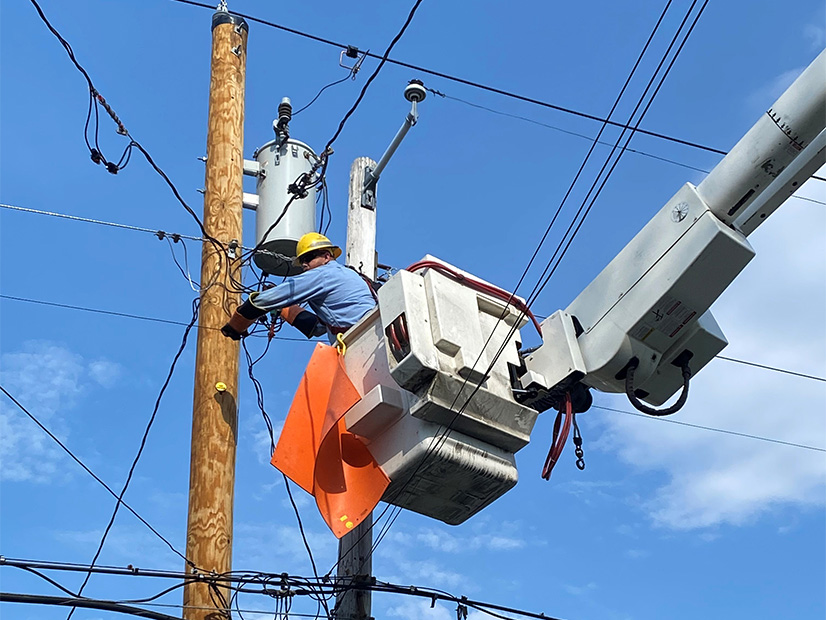The U.S. Department of Energy on April 4 finalized energy efficiency standards for distribution transformers to increase grid efficiency and save $824 million annually.
The congressionally mandated final standards give the industry an extra five years to comply. DOE said it adjusted them based on significant feedback from the industry and others after issuing its proposal last year. The longer time frame will give the industry time to ramp up production of grain-oriented electrical steel (GOES).
“The regulatory process can work, and this final rule shows just that by reflecting feedback from a broad spectrum of stakeholders,” Energy Secretary Jennifer Granholm said in a statement. “Ultimately, it will be a piece of the solution, rather than a barrier, to help resolve the ongoing distribution transformer shortage and keep America’s businesses and workers competitive.”
The final standards can primarily be met with GOES, most of which will be manufactured in the U.S., according to the department. Another small subset of new transformers can be manufactured with amorphous alloy, also expected to be manufactured domestically.
There are more than 60 million distribution transformers around the country, DOE said.
Efficiency improvements for transformers will cut wasted energy, saving $14 billion and cutting 85 million metric tons of CO2 emissions over 30 years, DOE estimates. The 30-year energy savings total 4.6 quadrillion BTUs, a savings of 10% compared to current products.
The initial proposal was going to shift the market to 95% of transformers being made from amorphous alloy, but the final standard can be met if 75% of transformers are made with GOES. The final rule also extends the compliance deadline from three to five years.
The standards are expected to protect the domestic supply of core materials used to build the transformers, increasing supply-chain resilience and preserving manufacturing jobs in Pennsylvania and Ohio, according to the department.
“I engaged directly with Secretary Granholm and the Biden administration to ensure Pennsylvanians’ concerns about the proposed rules were heard, and I want to thank them for making sure the final rule will allow for Butler Works to continue its existing line of steel production in Western Pennsylvania, while supporting upgrades that will help spur innovation, protect jobs and reduce carbon emissions from the plant,” Pennsylvania Gov. Josh Shapiro (D) said in a DOE statement.
The standards will significantly cut energy use by transformers, but they miss the chance for much larger savings, said the American Council for an Energy Efficient Economy. The final standards will save only one-third as much energy as the proposed standards would have.
“These standards significantly reduce energy waste, but they leave much bigger savings on the table,” Andrew deLaski, executive director of ACEEE’s Appliance Standards Awareness Project, said in a statement. “Passing up the savings that could have been achieved has a real cost for consumers, businesses and the climate.”
The GridWise Alliance said it was still reviewing the final rule, but it said the new framework will ensure that utilities can continue to make investments essential to maintaining the security and reliability of the grid.
The country is still experiencing a critical shortage of distribution transformers, with the lead time for procuring some types close to two years, GridWise said. The original standard could have exacerbated that shortage, but DOE recognized the industry’s concerns.
“I want to thank DOE for considering the challenges facing the grid industry and for listening to stakeholders in adapting the final rule to provide more certainty to the market for distribution transformers,” GridWise CEO Karen Wayland said. “Our GridWise members look forward to working with DOE to address the transformer shortage in the short term and in continually improving the efficiency of the electric grid over the long term.”
Louis Finkel, the National Rural Electric Cooperative Association’s senior vice president of government relations, agreed that the final rule is much improved over the proposal.
“The final rule provides stability for most of the market while affording a more gradual shift toward tighter efficiency standards for transformers used to meet larger commercial and certain electrification loads,” Finkel said. “We will work closely with our members, manufacturers and suppliers to ensure implementation does not further disrupt an already strained supply chain.”

